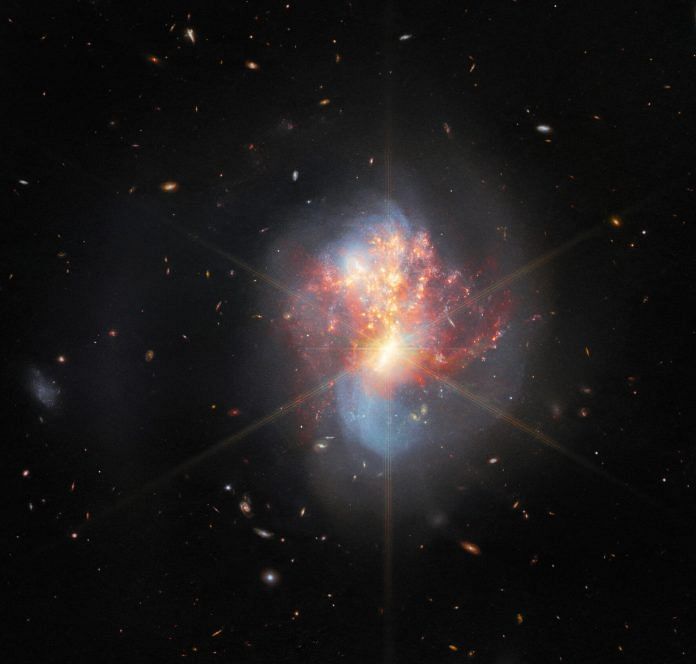New Delhi: The Webb telescope has spotted two galaxies plunging headlong into each other in a process known as galaxy merger.
The image shows an entwined pair of interacting galaxies, around 270 million light-years from Earth, whose collision has triggered what is called a starburst. The is creating new stars at a rate more than twenty times that of the Milky Way galaxy.
Results based on this observation were published in the Astrophysical Journal in August. The images were released by The European Space Agency Tuesday.
This interacting galaxy system is particularly bright at infrared wavelengths, making it a perfect proving ground for Webb’s ability to study luminous galaxies.
A team of astronomers captured IC 1623 across the infrared portions of the electromagnetic spectrum using a trio of Webb’s cutting-edge scientific instruments — MIRI, NIRSpec, and NIRCam.
This provided an abundance of data that will allow the astronomy community to unravel the complex interactions in galactic ecosystems. These observations are also accompanied by data from other observatories, including the NASA/ESA Hubble Space Telescope, and will help set the stage for future observations of galactic systems with Webb. Read more.
Also Read: Scientists identify molecule that may have been key to formation of life on Earth
Renewable plastic-like material made from wood fibres
Scientists from KTH, Royal Institute of Technology, Sweden, have created a new kind of degradable plastic from wood, that could be used in home furnishings and construction materials, with considerably less harm to the environment.
The study was published in Nature Communications on 27 September.
One of the goals of renewable wood composite development is to make materials strong enough to replace fossil-based materials used in home construction and furnishing, such as bathroom cabinets, doors, wall-boards and countertops. The resulting material should also be degradable to enable its recycling.
High fibre content is the key to the strength of materials like fibreglass, but it proved difficult to deliver a degradable wood composite without intensive heat damage from processes like melt-compounding.
In order to achieve higher fibre content, the researchers combined polymer chemistry with process technology similar to what is used for carbon fibre composites.
Everything is based on cheap and available raw materials, according to the Swedish team. The degradation products are also harmless to the environment, and can be reused.
The process still needs to be optimised before commercialisation. Read More.
Also Read: Scientists surprised by their discovery of heaviest element Barium in atmosphere of 2 exoplanets
Vocal communication evolved at least 400 million years ago
An international research team led by the University of Zurich (UZH) have found that the ability to use sounds for communication evolved at least 407 million years before in a common ancestor of turtles, tuataras, caecilians and lungfishes.
The study, published in Nature Neuroscience on 24 October, explained how the use of vocalisations as a resource for communication is common among several groups of vertebrates — singing birds, croaking frogs, and barking dogs being some well-known examples.
These vocalisations play a fundamental role in parental care, mate attraction and various other behaviours. Despite its importance, little is known about when and at what stage in the evolutionary history of vertebrates this behaviour first appeared.
The researchers studied vocal recordings and corresponding behaviour patterns of 53 species of turtles, tuataras, caecilians and lungfishes.
This, along with a broad literature-based dataset including 1,800 different species covering the entire spectrum shows that vocal communication is not only widespread in land vertebrates, but also found evidence of acoustic abilities in several groups previously considered non-vocal.
Many turtles, for example, which were thought to be mute do in fact show broad and complex acoustic repertoires.
To investigate the evolutionary origins of acoustic communication in vertebrates, the researchers combined relevant data on the vocalisation abilities of species like lizards, snakes, salamanders, amphibians, and dipnoi with phylogenetic trait reconstruction methods.
They were able to reconstruct acoustic communication as a shared trait among these animals, which is at least as old as their last common ancestor that lived approximately 407 million years ago. Read More.
Bees can produce as much electric charge as a storm cloud
By measuring the electrical fields near swarming honey bees, researchers at the University of Bristol have discovered that insects can produce as much atmospheric electric charge as a thunderstorm cloud.
This type of electricity helps shape weather events, aids insects in finding food, and lifts spiders up in the air to migrate over large distances.
The study, published in iScience Monday, demonstrates that living things can have an impact on atmospheric electricity.
As with most living creatures, bees carry an innate electric charge. Having found that honeybee hive swarms change the atmospheric electricity by 100 to 1,000 volts per metre, increasing the electric field force normally experienced at ground level, the team developed a model that can predict the influence of other species of insects. Read more.
(Edited by Theres Sudeep)
Also Read: Huge Tonga volcanic eruption this year led to bloom of microscopic marine life, find scientists



